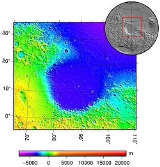
Isidis Planitia
Encyclopedia
Isidis Planitia is a plain located inside a giant impact basin
on Mars
, centered at 12.9°N 87.0°W. It is the third biggest impact structure on the planet after the Hellas
and Argyre
basins – it is about 1500 km in diameter. Due to dust coverage, it typically appears bright in telescopic views, and was mapped as a classical albedo feature
, Isidis Regio, visible by telescope in the pre-spacecraft era.
The Beagle 2
lander was about to land in the eastern part of Isidis Planitia in December 2003 when contact with the craft was lost. Just to the west of Isidis is Syrtis Major Planum, a low-relief shield volcano
that is also a prominent dark albedo feature of Mars, which formed after the basin.
Around the Isidis basin magnesium carbonate
was found by MRO
. This mineral indicates that water was present and that it was not acid. Life may have formed in this area.
The name "Isidis Planitia" follows the earlier name Isidis Regio ("Isis' Region"). Isis
is the Egyptian goddess
of heaven and fertility.
Impact crater
In the broadest sense, the term impact crater can be applied to any depression, natural or manmade, resulting from the high velocity impact of a projectile with a larger body...
on Mars
Mars
Mars is the fourth planet from the Sun in the Solar System. The planet is named after the Roman god of war, Mars. It is often described as the "Red Planet", as the iron oxide prevalent on its surface gives it a reddish appearance...
, centered at 12.9°N 87.0°W. It is the third biggest impact structure on the planet after the Hellas
Hellas Planitia
Hellas Planitia, also known as the Hellas Impact Basin, is a huge, roughly circular impact basin located in the southern hemisphere of the planet Mars. It is the second or third largest impact crater and the largest visible impact crater known in the Solar System...
and Argyre
Argyre Planitia
Argyre Planitia is a plain located in the Argyre impact basin in the southern highlands of Mars. Its name comes from a map produced by Giovanni Schiaparelli in 1877; it refers to Argyre, a mythical island of silver in Greek mythology....
basins – it is about 1500 km in diameter. Due to dust coverage, it typically appears bright in telescopic views, and was mapped as a classical albedo feature
Albedo feature
An albedo feature is a large area on the surface of a planet which shows a contrast in brightness or darkness with adjacent areas....
, Isidis Regio, visible by telescope in the pre-spacecraft era.
The Beagle 2
Beagle 2
Beagle 2 was an unsuccessful British landing spacecraft that formed part of the European Space Agency's 2003 Mars Express mission. All contact with it was lost upon its separation from the Mars Express six days before its scheduled entry into the atmosphere...
lander was about to land in the eastern part of Isidis Planitia in December 2003 when contact with the craft was lost. Just to the west of Isidis is Syrtis Major Planum, a low-relief shield volcano
Shield volcano
A shield volcano is a type of volcano usually built almost entirely of fluid lava flows. They are named for their large size and low profile, resembling a warrior's shield. This is caused by the highly fluid lava they erupt, which travels farther than lava erupted from more explosive volcanoes...
that is also a prominent dark albedo feature of Mars, which formed after the basin.
Around the Isidis basin magnesium carbonate
Magnesium carbonate
Magnesium carbonate, MgCO3, is a white solid that occurs in nature as a mineral. Several hydrated and basic forms of magnesium carbonate also exist as minerals...
was found by MRO
MRO
-Operations:* maintenance, repair, and operations -Companies:...
. This mineral indicates that water was present and that it was not acid. Life may have formed in this area.
The name "Isidis Planitia" follows the earlier name Isidis Regio ("Isis' Region"). Isis
Isis
Isis or in original more likely Aset is a goddess in Ancient Egyptian religious beliefs, whose worship spread throughout the Greco-Roman world. She was worshipped as the ideal mother and wife as well as the matron of nature and magic...
is the Egyptian goddess
Egyptian pantheon
The Egyptian pantheon consisted of the many gods worshipped by the Ancient Egyptians. A number of major deities are addressed as the creator of the cosmos. These include Atum, Ra, Amun and Ptah amongst others, as well as composite forms of these gods such as Amun-Ra. This was not seen as...
of heaven and fertility.

